Contract Law and the Con-Stan Case
VerifiedAdded on 2020/03/13
|11
|2506
|395
AI Summary
This assignment delves into the complexities of contract law through a critical analysis of the Con-Stan Case. It examines the High Court's reasoning in promoting contract law principles and elucidates the relevant provisions regarding implied contracts and case precedents. The analysis also critically evaluates the High Court's decision, concluding that it is sound in light of the facts presented.
Contribute Materials
Your contribution can guide someone’s learning journey. Share your
documents today.
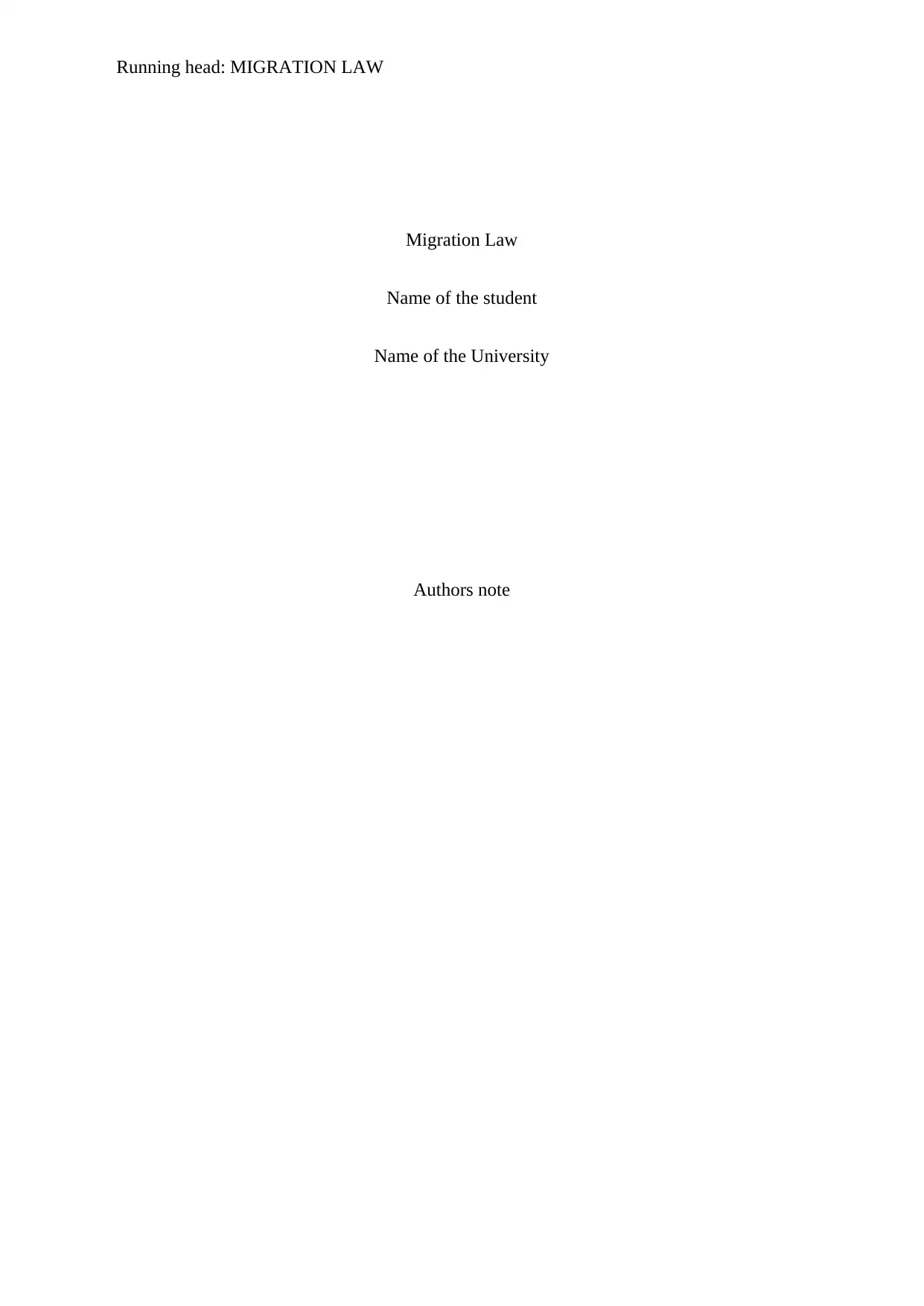
Running head: MIGRATION LAW
Migration Law
Name of the student
Name of the University
Authors note
Migration Law
Name of the student
Name of the University
Authors note
Secure Best Marks with AI Grader
Need help grading? Try our AI Grader for instant feedback on your assignments.
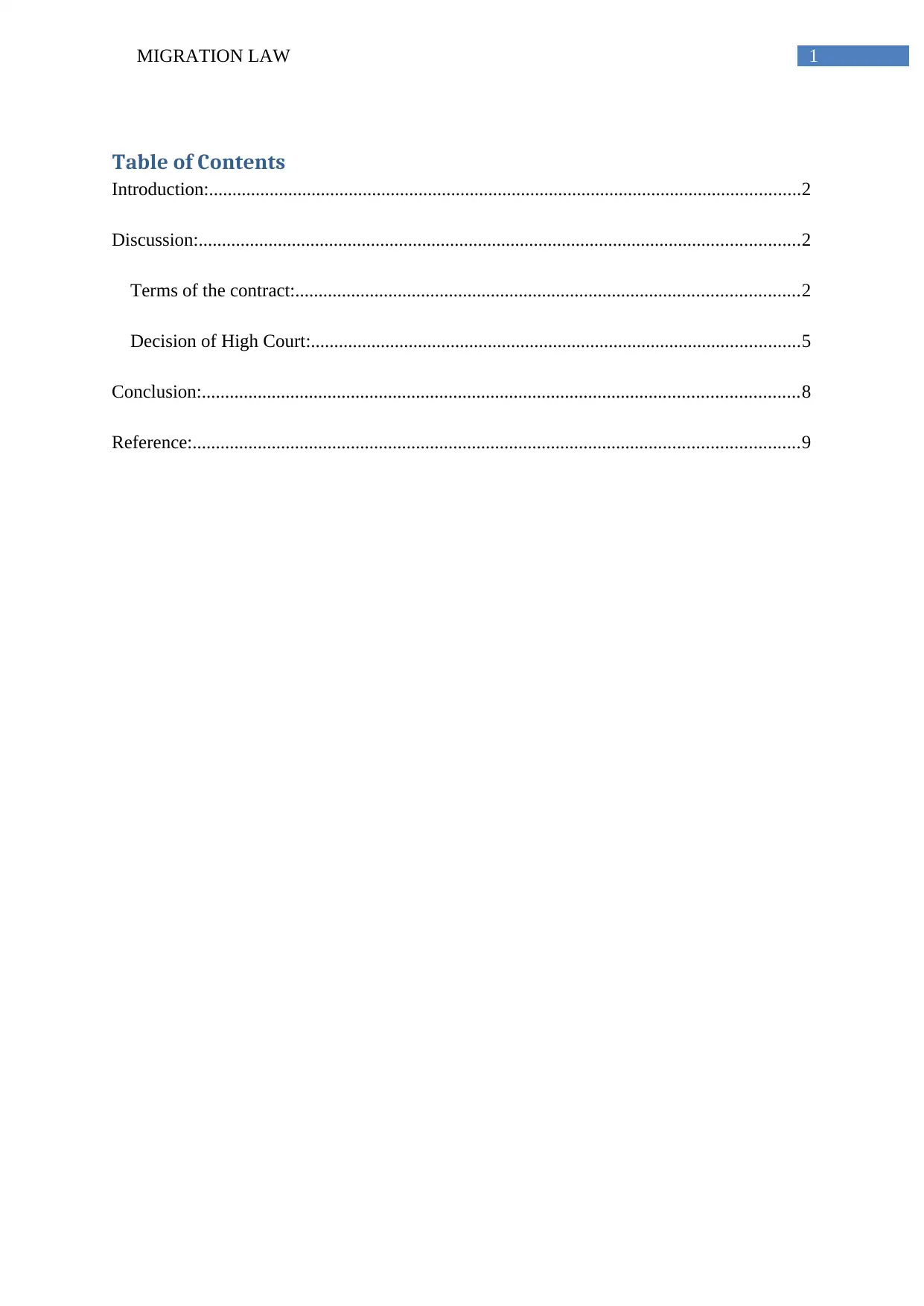
1MIGRATION LAW
Table of Contents
Introduction:...............................................................................................................................2
Discussion:.................................................................................................................................2
Terms of the contract:............................................................................................................2
Decision of High Court:.........................................................................................................5
Conclusion:................................................................................................................................8
Reference:..................................................................................................................................9
Table of Contents
Introduction:...............................................................................................................................2
Discussion:.................................................................................................................................2
Terms of the contract:............................................................................................................2
Decision of High Court:.........................................................................................................5
Conclusion:................................................................................................................................8
Reference:..................................................................................................................................9

2MIGRATION LAW
Introduction:
The present case is based on the provision of the contract law that is dealing with the
contractual relationship made between two or more parties and prescribes certain rights
regarding the same1. In Australia, the contract law is consists of certain terms of the contract.
There are provisions on the collateral contracts and certain principles are also depicted under
the Act2. The present case is based on the terms of the contract. In the present case, there has
been a provision regarding the implied terms of a contractual agreement that was made
between the Con Stan Industries v. Norwich Winterthur Insurance (1986) 160 CLR 226
regarding an insurance policy. Certain disputes between the two have been cropped up and it
became necessary for the right interpretation of the grounds of the Contract Act. There are
provision regarding the relevant topics of the contract Act and the decisions of the High
Court have been discussed. The method of classical understanding has also been discussed
under the case study. An attempt has been made regarding the proper functioning of the
provisions of the law has been briefly discussed.
Discussion:
Terms of the contract:
The case regarding the Con-Stan Industries has been raised in the year 1986, which
was filed before the High Court in Australia. The facts of the case are that Con Stan
industries appointed a broker who will be looked after the insurance policy taken by the
company. On suggestion of the broker, the company had taken certain insurance policies
from one Norwich and an agreement regarding the insurance contract had been made in
1 Carter, John W., David J. Harland, and Kevin E. Lindgren. Contract law in Australia. MICHIE, 2016.
2 McKendrick, Ewan. Contract law: text, cases, and materials. Oxford University Press (UK), 2014.
Introduction:
The present case is based on the provision of the contract law that is dealing with the
contractual relationship made between two or more parties and prescribes certain rights
regarding the same1. In Australia, the contract law is consists of certain terms of the contract.
There are provisions on the collateral contracts and certain principles are also depicted under
the Act2. The present case is based on the terms of the contract. In the present case, there has
been a provision regarding the implied terms of a contractual agreement that was made
between the Con Stan Industries v. Norwich Winterthur Insurance (1986) 160 CLR 226
regarding an insurance policy. Certain disputes between the two have been cropped up and it
became necessary for the right interpretation of the grounds of the Contract Act. There are
provision regarding the relevant topics of the contract Act and the decisions of the High
Court have been discussed. The method of classical understanding has also been discussed
under the case study. An attempt has been made regarding the proper functioning of the
provisions of the law has been briefly discussed.
Discussion:
Terms of the contract:
The case regarding the Con-Stan Industries has been raised in the year 1986, which
was filed before the High Court in Australia. The facts of the case are that Con Stan
industries appointed a broker who will be looked after the insurance policy taken by the
company. On suggestion of the broker, the company had taken certain insurance policies
from one Norwich and an agreement regarding the insurance contract had been made in
1 Carter, John W., David J. Harland, and Kevin E. Lindgren. Contract law in Australia. MICHIE, 2016.
2 McKendrick, Ewan. Contract law: text, cases, and materials. Oxford University Press (UK), 2014.
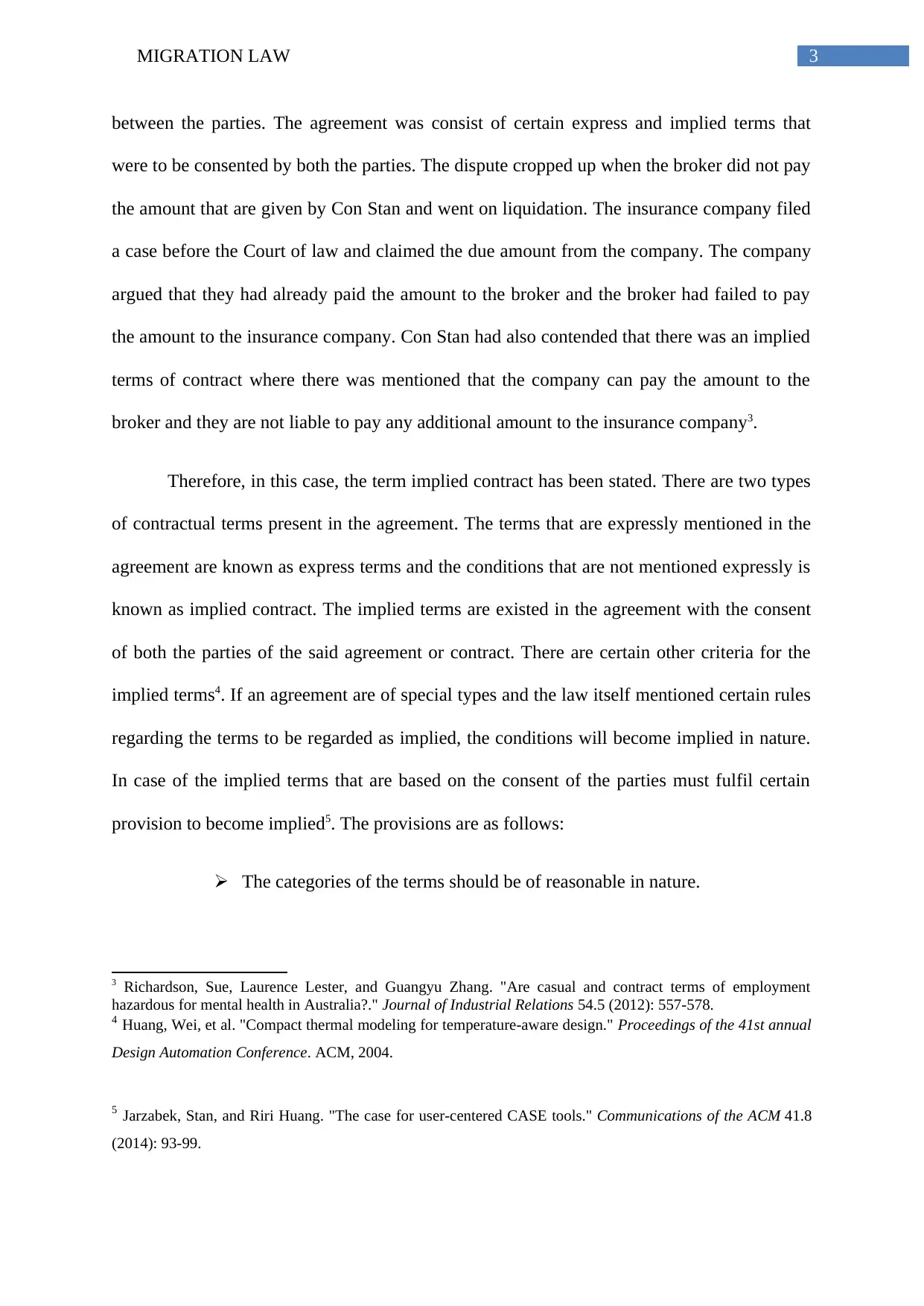
3MIGRATION LAW
between the parties. The agreement was consist of certain express and implied terms that
were to be consented by both the parties. The dispute cropped up when the broker did not pay
the amount that are given by Con Stan and went on liquidation. The insurance company filed
a case before the Court of law and claimed the due amount from the company. The company
argued that they had already paid the amount to the broker and the broker had failed to pay
the amount to the insurance company. Con Stan had also contended that there was an implied
terms of contract where there was mentioned that the company can pay the amount to the
broker and they are not liable to pay any additional amount to the insurance company3.
Therefore, in this case, the term implied contract has been stated. There are two types
of contractual terms present in the agreement. The terms that are expressly mentioned in the
agreement are known as express terms and the conditions that are not mentioned expressly is
known as implied contract. The implied terms are existed in the agreement with the consent
of both the parties of the said agreement or contract. There are certain other criteria for the
implied terms4. If an agreement are of special types and the law itself mentioned certain rules
regarding the terms to be regarded as implied, the conditions will become implied in nature.
In case of the implied terms that are based on the consent of the parties must fulfil certain
provision to become implied5. The provisions are as follows:
The categories of the terms should be of reasonable in nature.
3 Richardson, Sue, Laurence Lester, and Guangyu Zhang. "Are casual and contract terms of employment
hazardous for mental health in Australia?." Journal of Industrial Relations 54.5 (2012): 557-578.
4 Huang, Wei, et al. "Compact thermal modeling for temperature-aware design." Proceedings of the 41st annual
Design Automation Conference. ACM, 2004.
5 Jarzabek, Stan, and Riri Huang. "The case for user-centered CASE tools." Communications of the ACM 41.8
(2014): 93-99.
between the parties. The agreement was consist of certain express and implied terms that
were to be consented by both the parties. The dispute cropped up when the broker did not pay
the amount that are given by Con Stan and went on liquidation. The insurance company filed
a case before the Court of law and claimed the due amount from the company. The company
argued that they had already paid the amount to the broker and the broker had failed to pay
the amount to the insurance company. Con Stan had also contended that there was an implied
terms of contract where there was mentioned that the company can pay the amount to the
broker and they are not liable to pay any additional amount to the insurance company3.
Therefore, in this case, the term implied contract has been stated. There are two types
of contractual terms present in the agreement. The terms that are expressly mentioned in the
agreement are known as express terms and the conditions that are not mentioned expressly is
known as implied contract. The implied terms are existed in the agreement with the consent
of both the parties of the said agreement or contract. There are certain other criteria for the
implied terms4. If an agreement are of special types and the law itself mentioned certain rules
regarding the terms to be regarded as implied, the conditions will become implied in nature.
In case of the implied terms that are based on the consent of the parties must fulfil certain
provision to become implied5. The provisions are as follows:
The categories of the terms should be of reasonable in nature.
3 Richardson, Sue, Laurence Lester, and Guangyu Zhang. "Are casual and contract terms of employment
hazardous for mental health in Australia?." Journal of Industrial Relations 54.5 (2012): 557-578.
4 Huang, Wei, et al. "Compact thermal modeling for temperature-aware design." Proceedings of the 41st annual
Design Automation Conference. ACM, 2004.
5 Jarzabek, Stan, and Riri Huang. "The case for user-centered CASE tools." Communications of the ACM 41.8
(2014): 93-99.
Paraphrase This Document
Need a fresh take? Get an instant paraphrase of this document with our AI Paraphraser
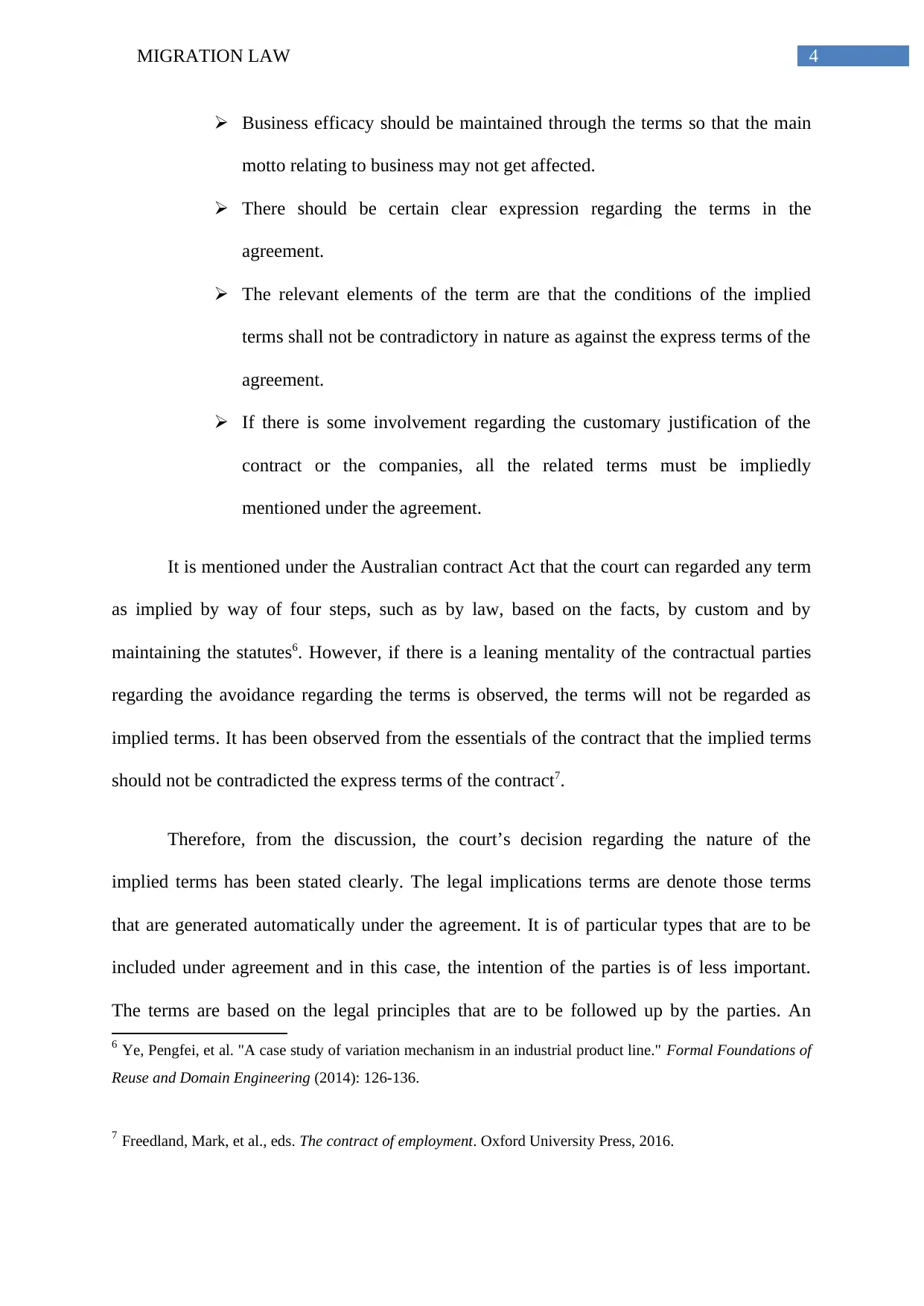
4MIGRATION LAW
Business efficacy should be maintained through the terms so that the main
motto relating to business may not get affected.
There should be certain clear expression regarding the terms in the
agreement.
The relevant elements of the term are that the conditions of the implied
terms shall not be contradictory in nature as against the express terms of the
agreement.
If there is some involvement regarding the customary justification of the
contract or the companies, all the related terms must be impliedly
mentioned under the agreement.
It is mentioned under the Australian contract Act that the court can regarded any term
as implied by way of four steps, such as by law, based on the facts, by custom and by
maintaining the statutes6. However, if there is a leaning mentality of the contractual parties
regarding the avoidance regarding the terms is observed, the terms will not be regarded as
implied terms. It has been observed from the essentials of the contract that the implied terms
should not be contradicted the express terms of the contract7.
Therefore, from the discussion, the court’s decision regarding the nature of the
implied terms has been stated clearly. The legal implications terms are denote those terms
that are generated automatically under the agreement. It is of particular types that are to be
included under agreement and in this case, the intention of the parties is of less important.
The terms are based on the legal principles that are to be followed up by the parties. An
6 Ye, Pengfei, et al. "A case study of variation mechanism in an industrial product line." Formal Foundations of
Reuse and Domain Engineering (2014): 126-136.
7 Freedland, Mark, et al., eds. The contract of employment. Oxford University Press, 2016.
Business efficacy should be maintained through the terms so that the main
motto relating to business may not get affected.
There should be certain clear expression regarding the terms in the
agreement.
The relevant elements of the term are that the conditions of the implied
terms shall not be contradictory in nature as against the express terms of the
agreement.
If there is some involvement regarding the customary justification of the
contract or the companies, all the related terms must be impliedly
mentioned under the agreement.
It is mentioned under the Australian contract Act that the court can regarded any term
as implied by way of four steps, such as by law, based on the facts, by custom and by
maintaining the statutes6. However, if there is a leaning mentality of the contractual parties
regarding the avoidance regarding the terms is observed, the terms will not be regarded as
implied terms. It has been observed from the essentials of the contract that the implied terms
should not be contradicted the express terms of the contract7.
Therefore, from the discussion, the court’s decision regarding the nature of the
implied terms has been stated clearly. The legal implications terms are denote those terms
that are generated automatically under the agreement. It is of particular types that are to be
included under agreement and in this case, the intention of the parties is of less important.
The terms are based on the legal principles that are to be followed up by the parties. An
6 Ye, Pengfei, et al. "A case study of variation mechanism in an industrial product line." Formal Foundations of
Reuse and Domain Engineering (2014): 126-136.
7 Freedland, Mark, et al., eds. The contract of employment. Oxford University Press, 2016.
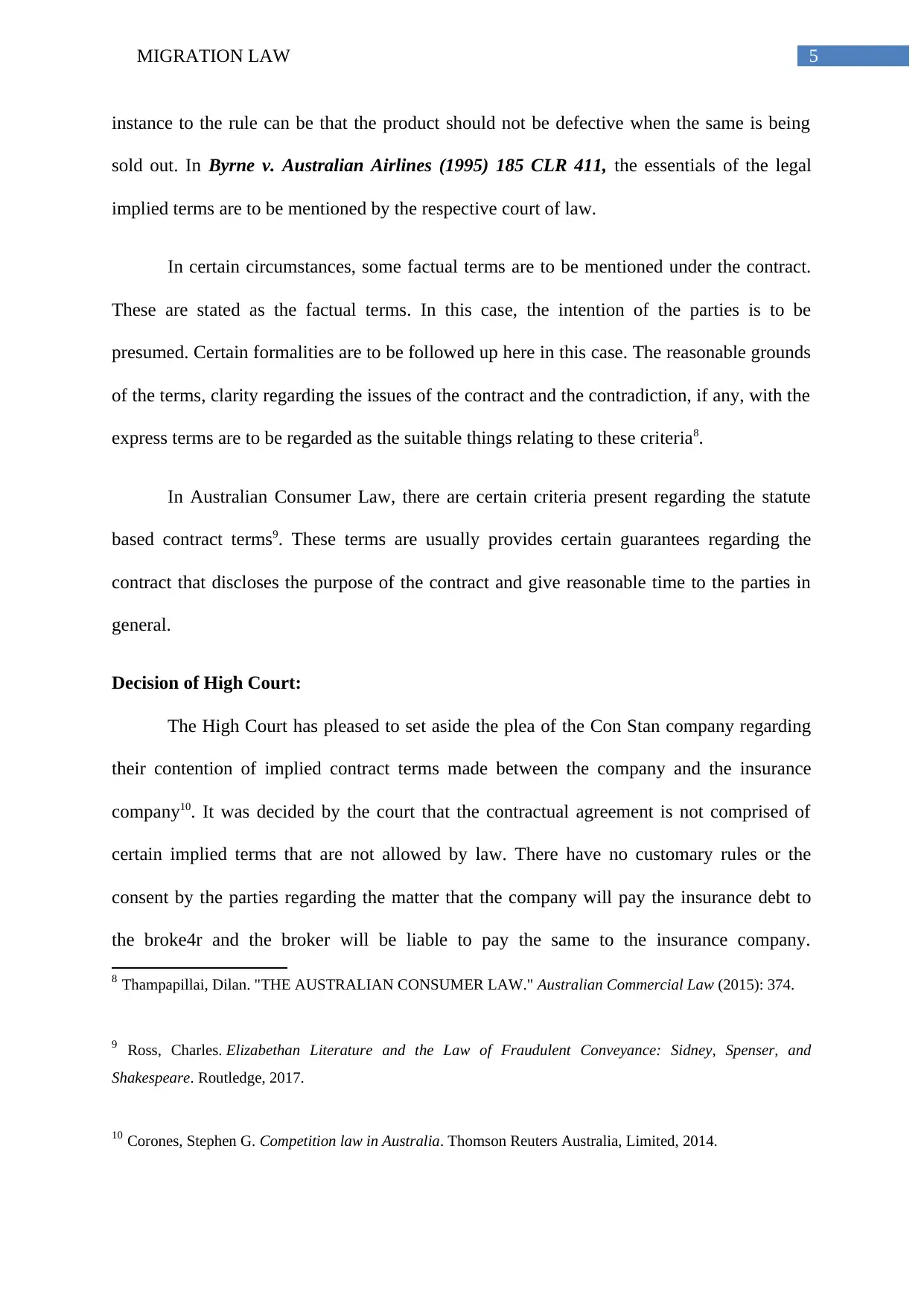
5MIGRATION LAW
instance to the rule can be that the product should not be defective when the same is being
sold out. In Byrne v. Australian Airlines (1995) 185 CLR 411, the essentials of the legal
implied terms are to be mentioned by the respective court of law.
In certain circumstances, some factual terms are to be mentioned under the contract.
These are stated as the factual terms. In this case, the intention of the parties is to be
presumed. Certain formalities are to be followed up here in this case. The reasonable grounds
of the terms, clarity regarding the issues of the contract and the contradiction, if any, with the
express terms are to be regarded as the suitable things relating to these criteria8.
In Australian Consumer Law, there are certain criteria present regarding the statute
based contract terms9. These terms are usually provides certain guarantees regarding the
contract that discloses the purpose of the contract and give reasonable time to the parties in
general.
Decision of High Court:
The High Court has pleased to set aside the plea of the Con Stan company regarding
their contention of implied contract terms made between the company and the insurance
company10. It was decided by the court that the contractual agreement is not comprised of
certain implied terms that are not allowed by law. There have no customary rules or the
consent by the parties regarding the matter that the company will pay the insurance debt to
the broke4r and the broker will be liable to pay the same to the insurance company.
8 Thampapillai, Dilan. "THE AUSTRALIAN CONSUMER LAW." Australian Commercial Law (2015): 374.
9 Ross, Charles. Elizabethan Literature and the Law of Fraudulent Conveyance: Sidney, Spenser, and
Shakespeare. Routledge, 2017.
10 Corones, Stephen G. Competition law in Australia. Thomson Reuters Australia, Limited, 2014.
instance to the rule can be that the product should not be defective when the same is being
sold out. In Byrne v. Australian Airlines (1995) 185 CLR 411, the essentials of the legal
implied terms are to be mentioned by the respective court of law.
In certain circumstances, some factual terms are to be mentioned under the contract.
These are stated as the factual terms. In this case, the intention of the parties is to be
presumed. Certain formalities are to be followed up here in this case. The reasonable grounds
of the terms, clarity regarding the issues of the contract and the contradiction, if any, with the
express terms are to be regarded as the suitable things relating to these criteria8.
In Australian Consumer Law, there are certain criteria present regarding the statute
based contract terms9. These terms are usually provides certain guarantees regarding the
contract that discloses the purpose of the contract and give reasonable time to the parties in
general.
Decision of High Court:
The High Court has pleased to set aside the plea of the Con Stan company regarding
their contention of implied contract terms made between the company and the insurance
company10. It was decided by the court that the contractual agreement is not comprised of
certain implied terms that are not allowed by law. There have no customary rules or the
consent by the parties regarding the matter that the company will pay the insurance debt to
the broke4r and the broker will be liable to pay the same to the insurance company.
8 Thampapillai, Dilan. "THE AUSTRALIAN CONSUMER LAW." Australian Commercial Law (2015): 374.
9 Ross, Charles. Elizabethan Literature and the Law of Fraudulent Conveyance: Sidney, Spenser, and
Shakespeare. Routledge, 2017.
10 Corones, Stephen G. Competition law in Australia. Thomson Reuters Australia, Limited, 2014.
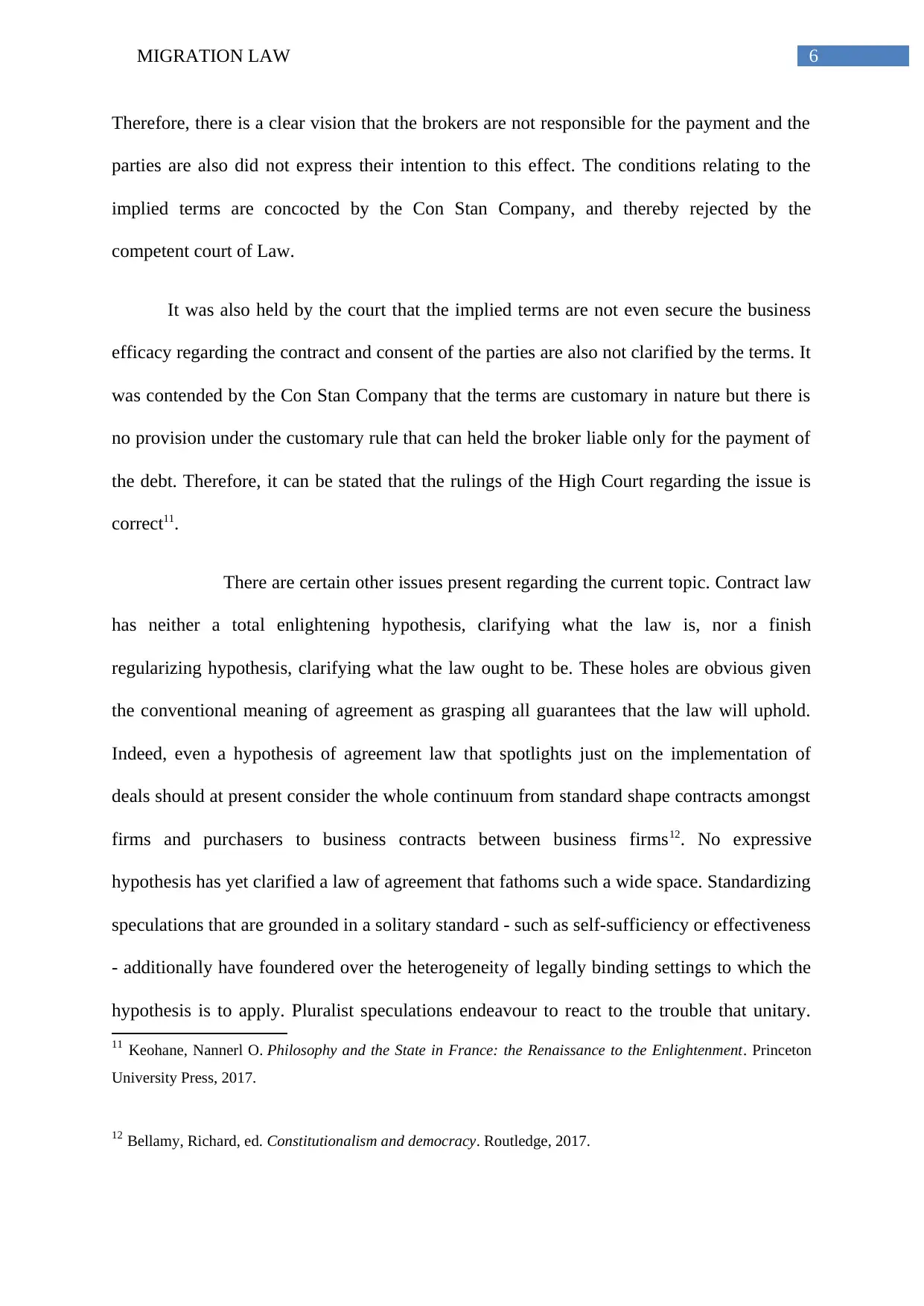
6MIGRATION LAW
Therefore, there is a clear vision that the brokers are not responsible for the payment and the
parties are also did not express their intention to this effect. The conditions relating to the
implied terms are concocted by the Con Stan Company, and thereby rejected by the
competent court of Law.
It was also held by the court that the implied terms are not even secure the business
efficacy regarding the contract and consent of the parties are also not clarified by the terms. It
was contended by the Con Stan Company that the terms are customary in nature but there is
no provision under the customary rule that can held the broker liable only for the payment of
the debt. Therefore, it can be stated that the rulings of the High Court regarding the issue is
correct11.
There are certain other issues present regarding the current topic. Contract law
has neither a total enlightening hypothesis, clarifying what the law is, nor a finish
regularizing hypothesis, clarifying what the law ought to be. These holes are obvious given
the conventional meaning of agreement as grasping all guarantees that the law will uphold.
Indeed, even a hypothesis of agreement law that spotlights just on the implementation of
deals should at present consider the whole continuum from standard shape contracts amongst
firms and purchasers to business contracts between business firms12. No expressive
hypothesis has yet clarified a law of agreement that fathoms such a wide space. Standardizing
speculations that are grounded in a solitary standard - such as self-sufficiency or effectiveness
- additionally have foundered over the heterogeneity of legally binding settings to which the
hypothesis is to apply. Pluralist speculations endeavour to react to the trouble that unitary.
11 Keohane, Nannerl O. Philosophy and the State in France: the Renaissance to the Enlightenment. Princeton
University Press, 2017.
12 Bellamy, Richard, ed. Constitutionalism and democracy. Routledge, 2017.
Therefore, there is a clear vision that the brokers are not responsible for the payment and the
parties are also did not express their intention to this effect. The conditions relating to the
implied terms are concocted by the Con Stan Company, and thereby rejected by the
competent court of Law.
It was also held by the court that the implied terms are not even secure the business
efficacy regarding the contract and consent of the parties are also not clarified by the terms. It
was contended by the Con Stan Company that the terms are customary in nature but there is
no provision under the customary rule that can held the broker liable only for the payment of
the debt. Therefore, it can be stated that the rulings of the High Court regarding the issue is
correct11.
There are certain other issues present regarding the current topic. Contract law
has neither a total enlightening hypothesis, clarifying what the law is, nor a finish
regularizing hypothesis, clarifying what the law ought to be. These holes are obvious given
the conventional meaning of agreement as grasping all guarantees that the law will uphold.
Indeed, even a hypothesis of agreement law that spotlights just on the implementation of
deals should at present consider the whole continuum from standard shape contracts amongst
firms and purchasers to business contracts between business firms12. No expressive
hypothesis has yet clarified a law of agreement that fathoms such a wide space. Standardizing
speculations that are grounded in a solitary standard - such as self-sufficiency or effectiveness
- additionally have foundered over the heterogeneity of legally binding settings to which the
hypothesis is to apply. Pluralist speculations endeavour to react to the trouble that unitary.
11 Keohane, Nannerl O. Philosophy and the State in France: the Renaissance to the Enlightenment. Princeton
University Press, 2017.
12 Bellamy, Richard, ed. Constitutionalism and democracy. Routledge, 2017.
Secure Best Marks with AI Grader
Need help grading? Try our AI Grader for instant feedback on your assignments.
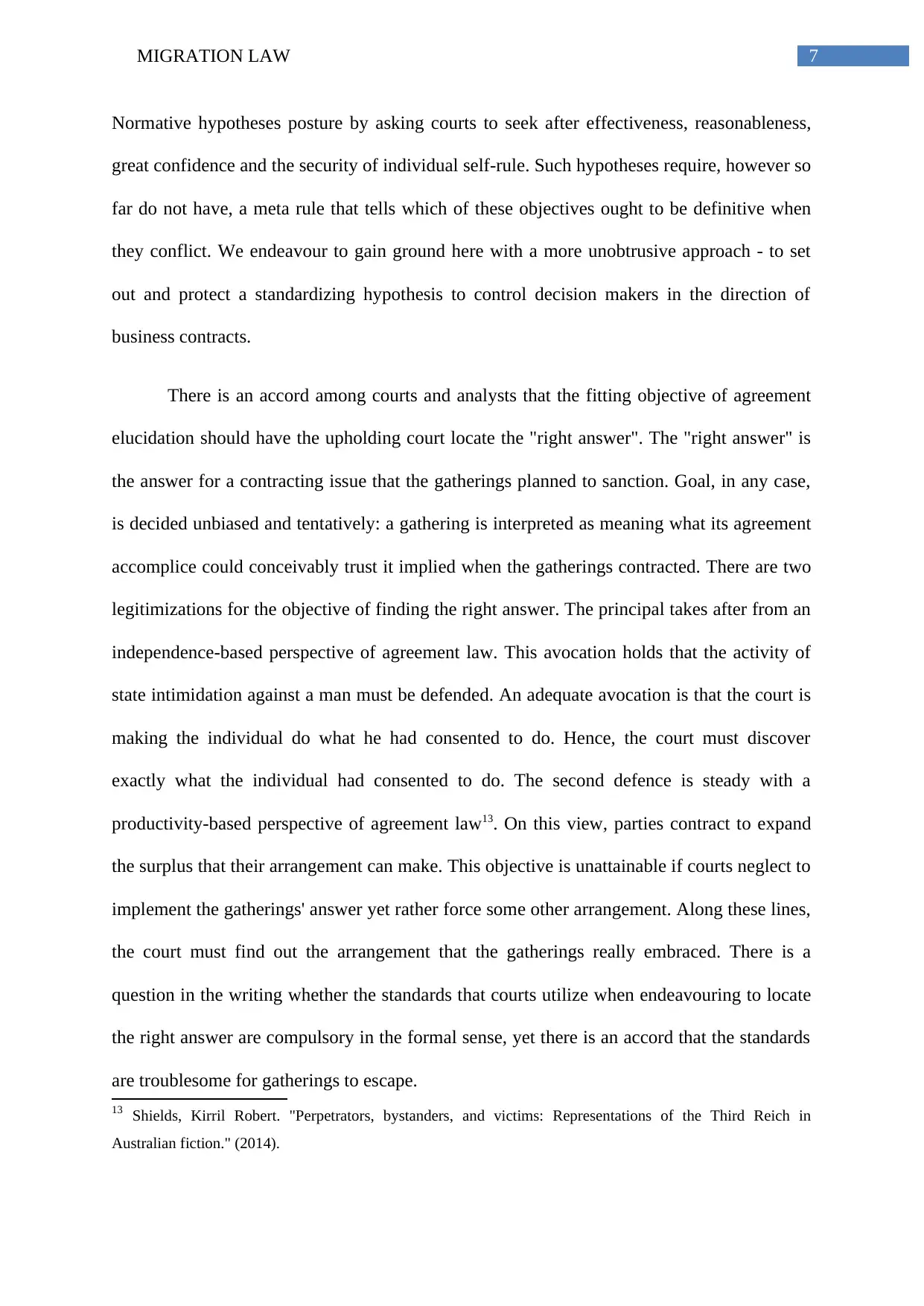
7MIGRATION LAW
Normative hypotheses posture by asking courts to seek after effectiveness, reasonableness,
great confidence and the security of individual self-rule. Such hypotheses require, however so
far do not have, a meta rule that tells which of these objectives ought to be definitive when
they conflict. We endeavour to gain ground here with a more unobtrusive approach - to set
out and protect a standardizing hypothesis to control decision makers in the direction of
business contracts.
There is an accord among courts and analysts that the fitting objective of agreement
elucidation should have the upholding court locate the "right answer". The "right answer" is
the answer for a contracting issue that the gatherings planned to sanction. Goal, in any case,
is decided unbiased and tentatively: a gathering is interpreted as meaning what its agreement
accomplice could conceivably trust it implied when the gatherings contracted. There are two
legitimizations for the objective of finding the right answer. The principal takes after from an
independence-based perspective of agreement law. This avocation holds that the activity of
state intimidation against a man must be defended. An adequate avocation is that the court is
making the individual do what he had consented to do. Hence, the court must discover
exactly what the individual had consented to do. The second defence is steady with a
productivity-based perspective of agreement law13. On this view, parties contract to expand
the surplus that their arrangement can make. This objective is unattainable if courts neglect to
implement the gatherings' answer yet rather force some other arrangement. Along these lines,
the court must find out the arrangement that the gatherings really embraced. There is a
question in the writing whether the standards that courts utilize when endeavouring to locate
the right answer are compulsory in the formal sense, yet there is an accord that the standards
are troublesome for gatherings to escape.
13 Shields, Kirril Robert. "Perpetrators, bystanders, and victims: Representations of the Third Reich in
Australian fiction." (2014).
Normative hypotheses posture by asking courts to seek after effectiveness, reasonableness,
great confidence and the security of individual self-rule. Such hypotheses require, however so
far do not have, a meta rule that tells which of these objectives ought to be definitive when
they conflict. We endeavour to gain ground here with a more unobtrusive approach - to set
out and protect a standardizing hypothesis to control decision makers in the direction of
business contracts.
There is an accord among courts and analysts that the fitting objective of agreement
elucidation should have the upholding court locate the "right answer". The "right answer" is
the answer for a contracting issue that the gatherings planned to sanction. Goal, in any case,
is decided unbiased and tentatively: a gathering is interpreted as meaning what its agreement
accomplice could conceivably trust it implied when the gatherings contracted. There are two
legitimizations for the objective of finding the right answer. The principal takes after from an
independence-based perspective of agreement law. This avocation holds that the activity of
state intimidation against a man must be defended. An adequate avocation is that the court is
making the individual do what he had consented to do. Hence, the court must discover
exactly what the individual had consented to do. The second defence is steady with a
productivity-based perspective of agreement law13. On this view, parties contract to expand
the surplus that their arrangement can make. This objective is unattainable if courts neglect to
implement the gatherings' answer yet rather force some other arrangement. Along these lines,
the court must find out the arrangement that the gatherings really embraced. There is a
question in the writing whether the standards that courts utilize when endeavouring to locate
the right answer are compulsory in the formal sense, yet there is an accord that the standards
are troublesome for gatherings to escape.
13 Shields, Kirril Robert. "Perpetrators, bystanders, and victims: Representations of the Third Reich in
Australian fiction." (2014).

8MIGRATION LAW
In our view, the present accord asks the wrong inquiry. A pledge to party power with
respect to the agreement's substantive terms suggests the further responsibility regarding
party sway with respect to the interpretive style an adjudicator should use to locate the
substantive terms. Gathering inclinations in regards to legal interpretive styles can vary. In
this manner, interpretive styles ought to be defaults. The significant inquiry, at that point, is
the thing that ought to be the majoritarian default. Put another way, the issue is not what
interpretive style is best figured to yield the right answer; Or maybe, the issue is the thing that
interpretive style would common gatherings need courts to utilize while endeavouring to
locate the right answer. We will contend here that the majoritarian default is Williston and
regular firms lean toward courts to make understandings on a restricted evidentiary base
whose generally noteworthy part is the composed contract. This proposed default would
switch the UCC's interpretive standards to the degree that they are defaults; the proposition is
more radical still if the Code's tenets are compulsory.
Conclusion:
Therefore, it is concluded in this context that the High Court’s reasoning in Con-Stan
Case is to promote the role of contract law rather to present an alternative explanation. There
are certain provisions regarding the implied methods are discussed in this case. Certain case
laws that are pre-decide the facts of the implied contracts are to be laid down here. The
decision of the High Court has also been discussed critically and it is decided that the
adjudication of High Court is correct as against Con Stan Company.
In our view, the present accord asks the wrong inquiry. A pledge to party power with
respect to the agreement's substantive terms suggests the further responsibility regarding
party sway with respect to the interpretive style an adjudicator should use to locate the
substantive terms. Gathering inclinations in regards to legal interpretive styles can vary. In
this manner, interpretive styles ought to be defaults. The significant inquiry, at that point, is
the thing that ought to be the majoritarian default. Put another way, the issue is not what
interpretive style is best figured to yield the right answer; Or maybe, the issue is the thing that
interpretive style would common gatherings need courts to utilize while endeavouring to
locate the right answer. We will contend here that the majoritarian default is Williston and
regular firms lean toward courts to make understandings on a restricted evidentiary base
whose generally noteworthy part is the composed contract. This proposed default would
switch the UCC's interpretive standards to the degree that they are defaults; the proposition is
more radical still if the Code's tenets are compulsory.
Conclusion:
Therefore, it is concluded in this context that the High Court’s reasoning in Con-Stan
Case is to promote the role of contract law rather to present an alternative explanation. There
are certain provisions regarding the implied methods are discussed in this case. Certain case
laws that are pre-decide the facts of the implied contracts are to be laid down here. The
decision of the High Court has also been discussed critically and it is decided that the
adjudication of High Court is correct as against Con Stan Company.
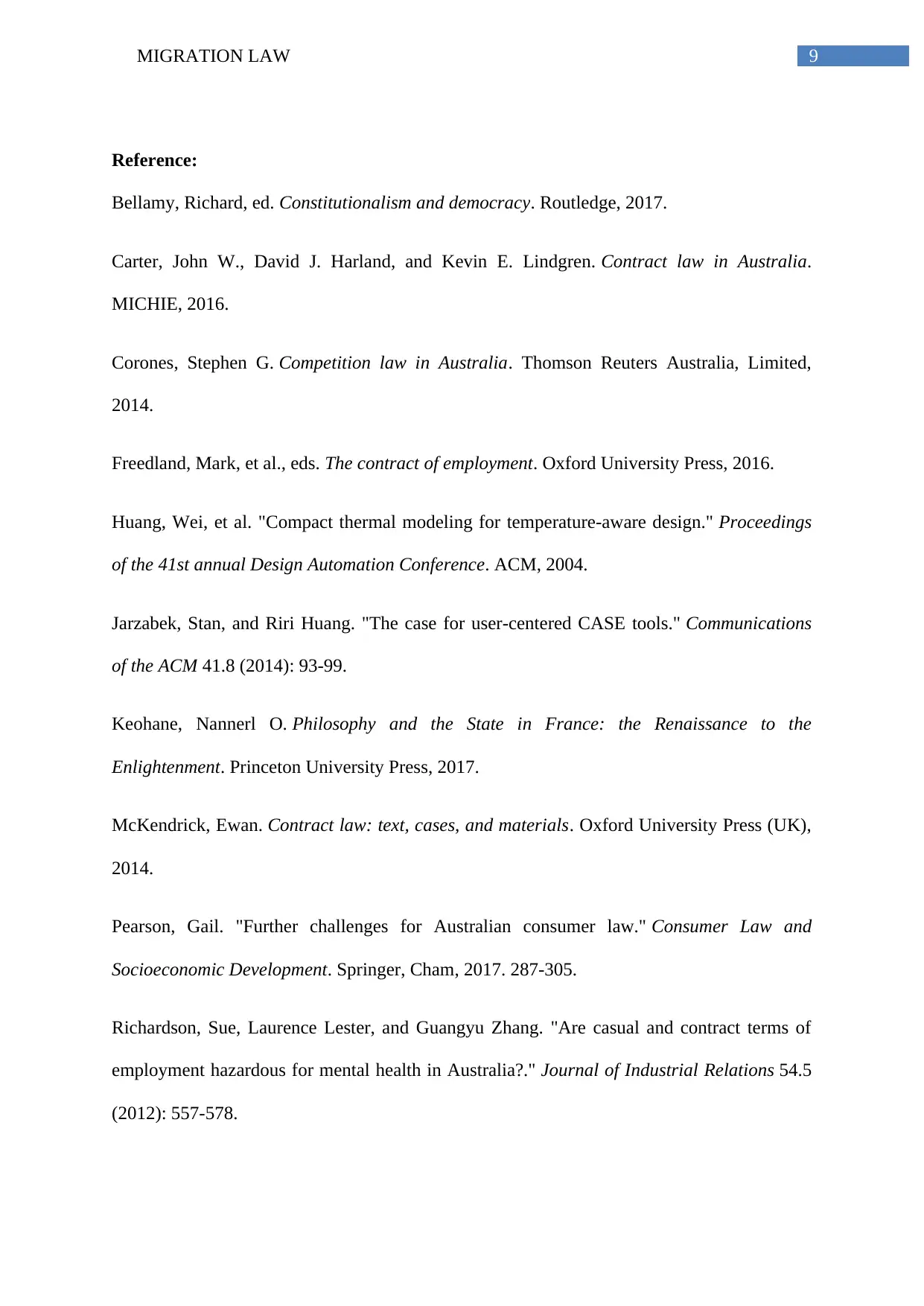
9MIGRATION LAW
Reference:
Bellamy, Richard, ed. Constitutionalism and democracy. Routledge, 2017.
Carter, John W., David J. Harland, and Kevin E. Lindgren. Contract law in Australia.
MICHIE, 2016.
Corones, Stephen G. Competition law in Australia. Thomson Reuters Australia, Limited,
2014.
Freedland, Mark, et al., eds. The contract of employment. Oxford University Press, 2016.
Huang, Wei, et al. "Compact thermal modeling for temperature-aware design." Proceedings
of the 41st annual Design Automation Conference. ACM, 2004.
Jarzabek, Stan, and Riri Huang. "The case for user-centered CASE tools." Communications
of the ACM 41.8 (2014): 93-99.
Keohane, Nannerl O. Philosophy and the State in France: the Renaissance to the
Enlightenment. Princeton University Press, 2017.
McKendrick, Ewan. Contract law: text, cases, and materials. Oxford University Press (UK),
2014.
Pearson, Gail. "Further challenges for Australian consumer law." Consumer Law and
Socioeconomic Development. Springer, Cham, 2017. 287-305.
Richardson, Sue, Laurence Lester, and Guangyu Zhang. "Are casual and contract terms of
employment hazardous for mental health in Australia?." Journal of Industrial Relations 54.5
(2012): 557-578.
Reference:
Bellamy, Richard, ed. Constitutionalism and democracy. Routledge, 2017.
Carter, John W., David J. Harland, and Kevin E. Lindgren. Contract law in Australia.
MICHIE, 2016.
Corones, Stephen G. Competition law in Australia. Thomson Reuters Australia, Limited,
2014.
Freedland, Mark, et al., eds. The contract of employment. Oxford University Press, 2016.
Huang, Wei, et al. "Compact thermal modeling for temperature-aware design." Proceedings
of the 41st annual Design Automation Conference. ACM, 2004.
Jarzabek, Stan, and Riri Huang. "The case for user-centered CASE tools." Communications
of the ACM 41.8 (2014): 93-99.
Keohane, Nannerl O. Philosophy and the State in France: the Renaissance to the
Enlightenment. Princeton University Press, 2017.
McKendrick, Ewan. Contract law: text, cases, and materials. Oxford University Press (UK),
2014.
Pearson, Gail. "Further challenges for Australian consumer law." Consumer Law and
Socioeconomic Development. Springer, Cham, 2017. 287-305.
Richardson, Sue, Laurence Lester, and Guangyu Zhang. "Are casual and contract terms of
employment hazardous for mental health in Australia?." Journal of Industrial Relations 54.5
(2012): 557-578.
Paraphrase This Document
Need a fresh take? Get an instant paraphrase of this document with our AI Paraphraser
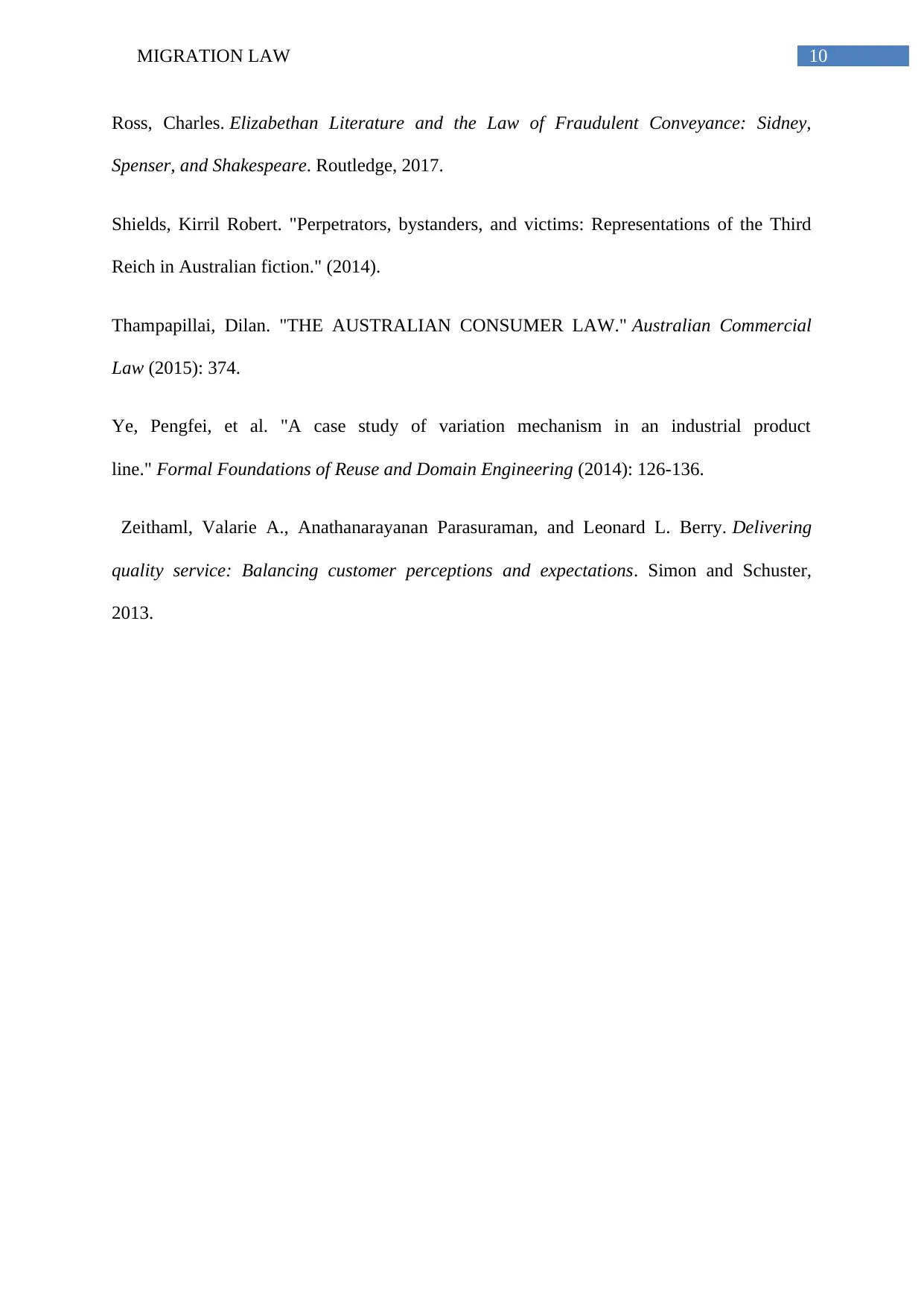
10MIGRATION LAW
Ross, Charles. Elizabethan Literature and the Law of Fraudulent Conveyance: Sidney,
Spenser, and Shakespeare. Routledge, 2017.
Shields, Kirril Robert. "Perpetrators, bystanders, and victims: Representations of the Third
Reich in Australian fiction." (2014).
Thampapillai, Dilan. "THE AUSTRALIAN CONSUMER LAW." Australian Commercial
Law (2015): 374.
Ye, Pengfei, et al. "A case study of variation mechanism in an industrial product
line." Formal Foundations of Reuse and Domain Engineering (2014): 126-136.
Zeithaml, Valarie A., Anathanarayanan Parasuraman, and Leonard L. Berry. Delivering
quality service: Balancing customer perceptions and expectations. Simon and Schuster,
2013.
Ross, Charles. Elizabethan Literature and the Law of Fraudulent Conveyance: Sidney,
Spenser, and Shakespeare. Routledge, 2017.
Shields, Kirril Robert. "Perpetrators, bystanders, and victims: Representations of the Third
Reich in Australian fiction." (2014).
Thampapillai, Dilan. "THE AUSTRALIAN CONSUMER LAW." Australian Commercial
Law (2015): 374.
Ye, Pengfei, et al. "A case study of variation mechanism in an industrial product
line." Formal Foundations of Reuse and Domain Engineering (2014): 126-136.
Zeithaml, Valarie A., Anathanarayanan Parasuraman, and Leonard L. Berry. Delivering
quality service: Balancing customer perceptions and expectations. Simon and Schuster,
2013.
1 out of 11
Related Documents
Your All-in-One AI-Powered Toolkit for Academic Success.
+13062052269
info@desklib.com
Available 24*7 on WhatsApp / Email
![[object Object]](/_next/static/media/star-bottom.7253800d.svg)
Unlock your academic potential
© 2024 | Zucol Services PVT LTD | All rights reserved.





